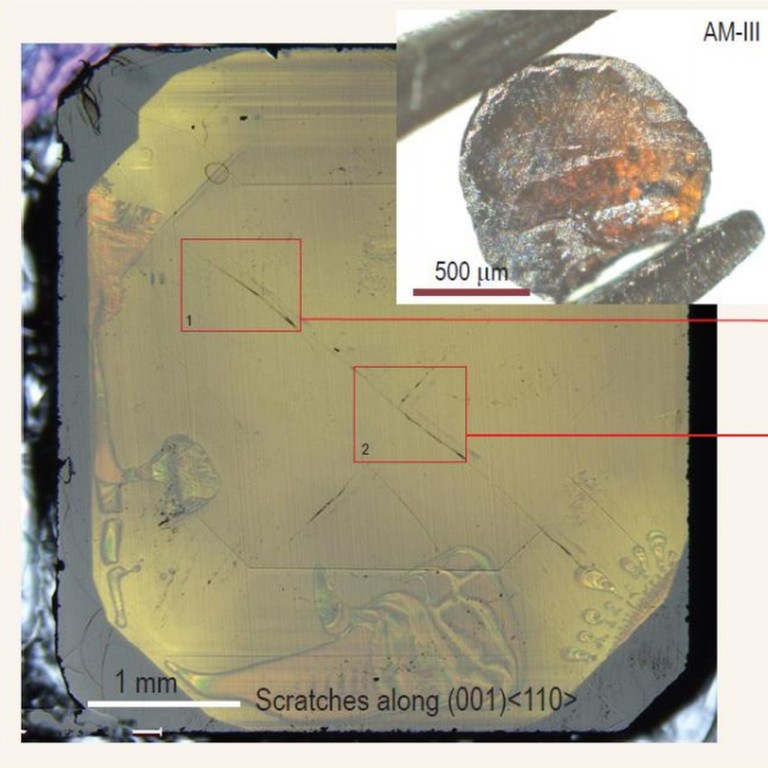
Chinese scientists develop glass as hard as a diamond
- It is hoped the transparent material, tentatively named AM-III, will have wide applications in the hi-tech industry
- AM-III is a semiconductor almost as efficient as silicon, with the ability to transfer electric current
Using a diamond to cut glass is not news, but a research team in northern China recently developed the world’s hardest glassy material that can leave a deep scratch on the surface of a diamond with ease.
The (tentatively named) AM-III, a transparent, somewhat yellowish material made entirely of carbon, reached 113 gigapascals (GPa) in a Vickers hardness test.
In comparison, a natural diamond stone usually scores 50 to 70, with some man-made pieces topping at 100 GPa.
Though mass production could be years away, and the price is unlikely to be cheap, a bulletproof window made with the AM-III could be 20 to 100 times tougher than some mainstream products currently in use.
How missile tech rocketed China to Olympic swimming gold
The glassy material does not look as attractive as jewellery, but it has some wide applications in the hi-tech industry, the researchers say.
The AM-III, for instance, is a semiconductor almost as efficient as silicon.
This ability to transfer electric current at will makes it a strong candidate for use in photoelectric devices, including weapons, that need to function in extreme environments such as high pressure and temperatures.
“The emergence of this type of ultrahard, ultrastrong, semiconducting amorphous carbon material offers excellent candidates to most demanding practical applications,” said Professor Tian Yongjun and colleagues with the Centre for High Pressure Science in Yanshan University in Qinhuangdao, Hebei province in a paper published in the journal National Science Review on Thursday.
Can China finally solve its military jet engine problems?
Diamond is a crystal. In crystals, atoms and molecules line up in perfect order and direction. But if there are multiple orders and directions, the internal structure turns into a mess and the material becomes glass.
Glass is, generally speaking, weak. But the AM-III is not strictly a piece of glass, but a glass with crystals inside, according to Tian and colleagues.
Under a microscope, the most detailed structures of the material appeared in order, just like crystals. But zooming out a bit would change the picture into a complete mess that looks like countless worms frozen in a dish.
This combination of order and disorder could give a material some unusual traits, the researchers discovered.
They produced numerous types of new materials with different order-disorder combinations. The AM-III had the highest proportion of atoms and molecules in order, to achieve the highest strength.

The orderly structures could not increase further, however, because it would turn the material into diamond and kill the semiconductivity and some other properties that could only exist in materials in chaotic state.
In 2013, Tian’s team created the world’s hardest material that could be seen by naked eyes, a boron nitride crystal twice (200 GPa) as hard as diamond, and the record still stands.
But in some ways, making super strong glass was more complicated than crystal.
Man-made diamonds are produced from cheap graphite under heat and pressure. The manufacturing of AM-III requires fullerene, a more sophisticated material consisting of molecules similar to footballs with a hollow structure made up of carbon atoms.
The fullerene was so soft that it was used in some cosmetic products. Under increasing heat and pressure, however, the carbon “footballs” would be crushed and blended together.
Seven scientific sectors to get extra funds as China pushes for global standing
Tian and colleagues increased the pressure in the experimental chamber to 25 GPa and temperature to 1,200 degrees Celsius (2,192 degrees Fahrenheit).
Some other teams had tempered with fullerene before, but none tried such extreme conditions because they feared it would turn the material into diamond.
The experiment could have failed in a rush, according to the Chinese team.
They spent more than 12 hours gradually increasing the heat and pressure to the maximum, and spent an equal amount of time letting the material cool down slowly.
There has been heated competition to create super-hard materials in the world but the AM-III was born of international cooperation.
Can a new coating save military from rusting away in South China Sea?
Scientists from Sweden, United States, Germany and Russia participated in the experiment in China. These overseas collaborators had helped the Chinese team by coming up with new ideas and analysing data, according to their paper.
Scientists have created many strong materials. Graphene, for instance, can stand against more than 400 GPa in theory. But such strength only exists when the material is one atom thick. Stacking many layers of graphene together would turn it into soft, ordinary graphite.
As a result, the applications of many super-hard materials were limited to a thin coating over the surface of another material.
The AM-III can be produced in various shapes and sizes, though. And unlike diamond, which has some weak surfaces because of the singular alignment of its atoms, the AM-III is hard all around.
These properties will further increase the potential of its applications, according to the researchers.

